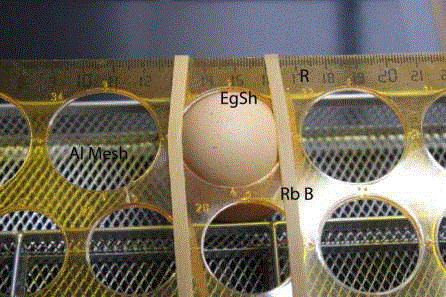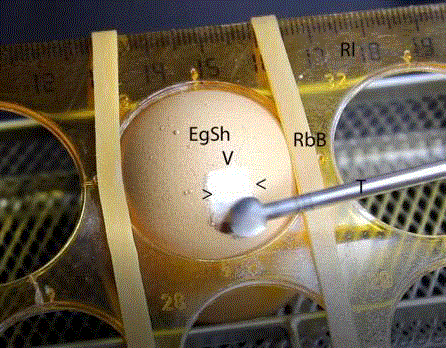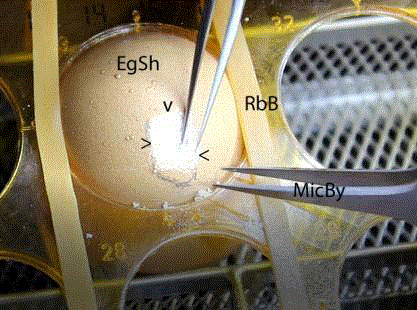Research Article
Using of Chicken Eggshell in the Microneusurgical Training Model for Microdrilling of Sella Floor
Cengiz Cokluk*
1Department of Neurosurgery, Ondokuzmayis University, Turkey
*Corresponding author: Cengiz Cokluk, Department of Neurosurgery, Cengiz Cokluk, Ondokuzmayis University, Samsun, Turkey
Published: 13 Jun, 2017
Cite this article as: Cokluk C. Using of Chicken Eggshell in
the Microneusurgical Training Model for
Microdrilling of Sella Floor. Clin Surg.
2017; 2: 1512.
Abstract
Objective: Repetitive practicing of microneurosurgical techniques in experimental laboratory using real surgical instruments on training models is extremely important before starting the real
surgical interventions. In this experimental study, it was created a laboratory-training model for
microneurosurgical drilling of delicate and thin cranial base bones.
Methods: Twenty-five boiled chicken eggshell for five minutes were used for this study. The
difficulty and suitability of the model was evaluated in terms of the usability in the training of
microneruosurgical microdrilling. The objective criterion for the evaluation of the difficulty of
the procedure was the protection of the membrane during the procedure. The suitability of the
procedure was evaluated within three groups as bad, good, and perfect.
Results: In four (16%) eggshells, the difficulty of the microdirilling was evaluated as difficult. Fifteen
(60%) of the eggshells were microdrilled with easy procedure. The remaining six (24%) of the
eggshells microdrilling was evaluated as very easy. The suitability of the model was evaluated as bad
in three (12%) of the eggshells. The suitability was found as good in 16 (64%) of the eggshell. In the
remaining three (24%) of the eggshells microdrilling, the suitability of the model was evaluated as
perfect.
Conclusion: Consolidation of the surgical practice in a laboratory setting, grasping and using of
microsurgical instruments, can be repeated in several times in this model. We believe that this
model will contribute to the practical training of microneurosurgery.
Keywords: Microneurosurgery; Training of microsurgery; Microdrilling; Eggshell
Introduction
Theoretical and practical training of microneurosurgery includes many difficult, time and
ability requiring steps in neurosurgical period of life [1,2,3]. Specific microneurosurgical techniques
such as properly using of the operative microscope, holding and grasping of the microneurosurgical
instruments, proper microsurgical technique of the opening of the arachnoid membranes, safe
and delicate neurovascular dissection, and carefully and properly microdrilling of the cranial base
bones should be learnt before taking place in front of the patient’s head in the operating room
[1,4-7]. Theoretical knowledge, practical techniques, and microsurgical operative disciplines are
mainly provided during the residency years of neurosurgical education [1,3]. These basic and
essential practicing gained during the residency years are not sufficient to safely do some kinds of
microneurosurgical interventions to the patients [4-6]. Because of these reasons many neurosurgeons
interested in microneurosurgery try to gain some additional and advanced progress in the improving
their microneurosurgical ability [1,3-7]. Spending of time in experimental microsurgical laboratory
to practice some kind of microsurgical models such as dissection and suturing of the rat external
carotid artery, dissection and evaluation of the abdominal vena cava of rats, suturing of the plastic
glove materials by using microforceps under the operating microscope, drilling and dissection of
some cadaveric bone materials are essential improving and gaining of advanced microneurosurgical
practical techniques [1,3-7].
Removing of the bony structures located in the cranial base are necessary during the intervention
of some kind of operations such as intranasal transsphenoidal hypophysis surgery [2]. In the other
hand, intradurally and/or extradurally removing of the thin and delicate bony structures overlying
of some important and critical neural and vascular structures needs advanced microsurgical
microdrilling techniques before performing of operations. Using of the microsurgical instruments
(in our case using of the electrically powered high-speed microdrill with its different tips) on the
thin and delicate bony structure of the Sella Turcica floor covering
over the hypophysis, bilaterally internal carotid artery, unilayer of the
dura mater, circular venous sinus, and bilaterally the medial wall of
the cavernous structure are extremely important without any surgical
injury during the bony microdrilling step of the operation [2].
In this experimental study, it was developed a practical model by
using chicken eggs in the microsurgical training model for drilling of
the Sella Turcica floor. Anatomically, the outer shell of the chicken
eggs is an eligible model for the bony structure of sellar floor. The
delicate membranous structure located under the eggshell is and
acceptable and appropriate model for the uni-layer dura mater located
under the bony structure of the Sella Turcica floor. The structural
material located inside the chicken eggs turns solid materials after the
boiling of the chicken eggs within the boiling water [8,9]. It is very
easy and cheap materials to find in common daily of life.
In this experimental modeling study, it was evaluated that the
removing of chicken eggshell using high-speed microdrill in the
contribution of the using and handling ability of the microdrill. In
the other hand, it was also evaluated that the feasibility of the using
of this model in the micro drilling of the Sella Turcica floor in clinical
microsurgical practice. Experimental findings, difficulties, practical
methods and suggestions were discussed under the light of the
literature.
Figure 1
Figure 1
This figure shows the details of the experiment.
Al Mesh: Aluminum Mesh Tray; EgSh: Eggshell; RbB: Rubber Band
Figure 2
Figure 2
The microdrilling of the eggshell.
EgSh: Eggshell; RbB: Rubber Band; Rl: Ruler, the arrows show the
microdrilling area
Figure3
Figure 3
This figure shows the dissection and separation of the eggshell
membrane.
EgSh: Eggshell; RbB: Rubber Band; MicBy: Microbayonet, arrows show the
dissection area
Materials and Methods
This study was performed in Microneurosurgery laboratory of
Neurosurgery Department, Faculty of Medicine. Thirty-five chicken
eggshells were used in this experimental feasibility study. The eggs
were boiled for five minutes before processing. After five minutes, the
eggs were removed from boiling water and allowed to cool in room
temperature. Aluminum wire mesh tray was used for stabilization
of the eggs under the operating surgical microscope (Zeiss Surgical
Microscope, Germany). Rubber elastic bands were used for fixing
of the eggshell in the aluminum mesh tray (Figure 1). The rectangle
plastic ruler with circular openings over its large flat surface was used
for more stabilization and fixation of the eggshell under the surgical
microscope before starting the procedure (Figure 1). Using pencil, the
operating area was marked before starting the microsurgical drilling
procedure. Using high-speed microsurgical drill (Midas Rex® Legend®
Electric System, USA), the superior, inferior and lateral surface of the
chicken eggshells was micro-drilled with proper attachment (Small
Bore Variable Exposure Attachment) and tools (5 mm ball and 5 mm
ball diamond) of the Midas Rex® Legend® Electric System for opening
of the burr-holes (Figure 2). Interior membranous dissection and
separation was performed using micro-forceps, micro-dissector and
micro-hook (Figure 3).
Difficulty and suitability of the procedure was analyzed in the
evaluation of the model for sella floor drilling. Difficulty of the
procedure was divided as four degree (very easy, easy, difficult, and
very difficult) in according to the description of the performer (CC).
The main objective criterion for the difficulty of the procedure was
described as the protection of the eggshell membrane along the
performing of the procedure. The suitability of the procedure was also
evaluated within three groups as bad, good, and perfect.
Results
In four (16%) eggshells, the difficulty of the microdirilling was evaluated as difficult. Fifteen (60%) of the eggshells were microdrilled with easy procedure. The remaining six (24%) of the eggshells microdrilling was evaluated as very easy. The suitability of the model was evaluated as bad in three (12%) of the eggshells. The suitability was found as good in 16 (64%) of the eggshell. In the remaining three (24%) of the eggshells microdrilling, the suitability of the model was evaluated as perfect. Microsurgical drilling of the superior, inferior and lateral wall of the chicken eggshell, and enabling repetitive drilling are indications of the suitability of the material. There is airspace under the inferior end of the eggshell. The microsurgical drilling of the inferior end without membranous rupture is more difficult in comparison with microdrilling of the superior tip. All treated surface should be equally microdrilled for the successful drilling process. Outer layer of the chicken eggshell is harder than inner layer because of its amorphous calcium carbonate content. The inner layer is softer than outer layer and it has some similar properties to normal bones. Microsurgical drilling of the eggshell without any membranous injury located just inner surface of the outer eggshell is an indication of the successfully surgical microdrilling process. Microforceps, microhook, and microdissector may also be used in the identification, separation and dissection of the inner membranous structure to imitate microsurgical steps (separation and dissection of the dura mater). Microdrill tips with different features and sizes may be able to use in this model. The rotation speed of the microdrill and the effect of rotation speed on the microdrilling process may be evaluated in this experimental model.
Discussion
Regional microneurosurgical neuroanatomy and microsurgical
instruments should be known and recognized for a safe
microneurosurgical intervention [1]. It is crucial the using of these
instruments with appropriate microsurgical technique [1]. It is
imperative that surgical techniques should be repeated several times
on appropriate models to successfully maintain and terminate
microsurgical interventions [1]. Before a real operation performing on
human beings, it is extremely necessary that understanding of abilities
of some sophisticated devices to be used in the microneurosurgical
intervention, and in addition, it is required for the person to develop
his or her own abilities and to create integrated surgical techniques
[1,3-7]. Microneurosurgical operation performed on human subjects
can be properly staged. Each step carries unique features. In training
of microneurosurgery, stepped or staged microsurgical training is the
most commonly used learning methods. Vascular end to end, end
to side, side-to-side anastomosis, aneurysm clipping, and sylvian
fissure dissection may be given as example for staged microsurgical
training [3-7]. In this model, using of chicken eggshell microdrilling
is proposed as a training model for delicate and thin cranial base of
the Sella Turcica.
First essential feature, in order to speak of an appropriate and
successful model is the partial similarities of the represented model.
On the other hand, another important issue is the easily obtainable
and cheap properties. Other important issues are the short and easy
preparation period of the model before using under the operating
microscope without including any complicated steps. Repetitive
operations on the model in various ways can be accountable as a
positive advantage. When taking into consideration the ethical issues,
live models, in addition to the above mentioned disadvantages,
compromise some problematic limitations in experimental practice.
It can be seen some advantages when we evaluate the eggshell under
the light of the parameters detailed above. Eggshell has some similar
features in comparison with the floor of the Sella Turcica in terms of
size and shape.
The eggshell is an inexpensive material that can be obtained
easily because the egg is a food source consumed through nutrition.
The eggshell can be used as an experimental material after boiled
for five minutes and then cooled. The same material is suitable for
microdrilling without boiling. The advantage of boiled egg is that
it can be processed many times on many places because it is a solid
material. This can be regarded as a positive advantage. Because the
egg is not a living model, there is no need for local ethical committee
permission. So there are no ethical restrictions in this model in
comparison with live models.
When we think of all these features together, the eggshell should be
regarded as a suitable model in the experimental microneurosurgical
microdrilling of the floor of the Sella Turcica training model. The
eggshell has some rigid and harder features in comparison with
human bone due to the extensive amount of amorphous calcium
carbonate and the limited amount of the collagen material in the
contents of the outer shell [8,9]. This feature can be considered as a
disadvantage of the model.
When the egg is not boiled the egg content is completely liquid,
so care must be taken that the membrane under the eggshell is not
damaged during the microdrilling process. If the egg is boiled for three
minutes, the outer layer of the egg content will solidify and the inner
layer will become a cystic pattern filled with liquid colloidal material.
It is also important to recognize the specific surgical instruments used
in this proposed model and gain some practice by trying them out in
various ways. High-speed microdrill can be accepted as the top of these
instruments. Allowing microdrills to be used in this experimental
model with different tips and types makes the person more familiar
with this device. The process of reducing and increasing the turning
speed of the microdrill and observation of the events to occur during
this process can be accounted as the other purpose of this practice.
During the chain of processing, the process of the removing of the
most outer layer from the membrane located under the eggshell is
another important step. The use of the microhook in the dissection of
the inner membrane from the rigid outer shell can also be practiced.
Using of the microdissector to produce pressure to the membrane for
separation can be used for practicing.
Conclusion
Removing of the thin and delicate bone structure of the cranial base by using micro drilling is one of the most important steps of the surgical intervention in the microneurosurgical practice. Before starting the surgical intervention performing on live subjects, this process should be practiced several times on practical training models such as in this proposed model in several times until practically learning. In this experimental study, chicken eggshells are proposed as a practical and viable model. Consolidation of the surgical practice in a laboratory setting, grasping and using of microsurgical instruments, can be repeated in several times in this model. We believe that this model will contribute to the practical training of microneurosurgery.
References
- Cokluk C, Aydin K. Maintaining microneurosurgical ability via staying active in microneurosurgery. Minim Invasive Neurosurgery 2007;50:324-7.
- Kiran NAS, Furtado SV, Hedge AS. How I do it: Anterior clinoidectomy and optic canal unroofing for microneurosurgical management of ophthalmic segment aneurysms. Acta Neurochir 2013;155:1025-9.
- Yadav YR, Parihar V, Ratre S, Kher Y, Iqbal M. Microneurosurgical Skills Training. J Neurol Surg A Cent Eur Neurosurg. 2016;77(2):146-54.
- Altunrende ME, Hamamcioglu MK, Hicdonmez T, Akcakaya MO, BirgiliB, Cobanoglu S. Microsurgical training model for residents to approach to the orbit and the optic nerve in fresh cadaveric sheep cranium. J Neurosci Rural Pract. 2014;5:151-4.
- Belykh E, Byvaltsev V. Off-the-job microsurgical training on dry models: Siberian experience. World Neurosurg. 2014; 82:20-4.
- Turan Suslu H, Ceylan D, Tatarli N, Hicdonmez T, Seker A, Bayri Y. Laboratory training in the retrosigmoid approach using cadaveric silicone injected cow brain. Br J Neurosurg. 2013; 27:812-4.
- Spetzger U, von Schilling A, Brombach T, Winkler G. Training models for vascular microneurosurgery. Acta Neurochir Suppl. 2011;112:115-9.
- Hincke MT, Nys Y, Gautron J, Mann K, Rodriguez-Navarro AB, McKee MD. The eggshell: structure, composition and mineralization. Front Biosci (Landmark Ed). 2012;17:1266-80.
- Nakano T, Ikawa NI, Ozimek L. Chemical composition of chicken eggshell and shell membranes. Poultry Science. 2003; 82: 510-4.



